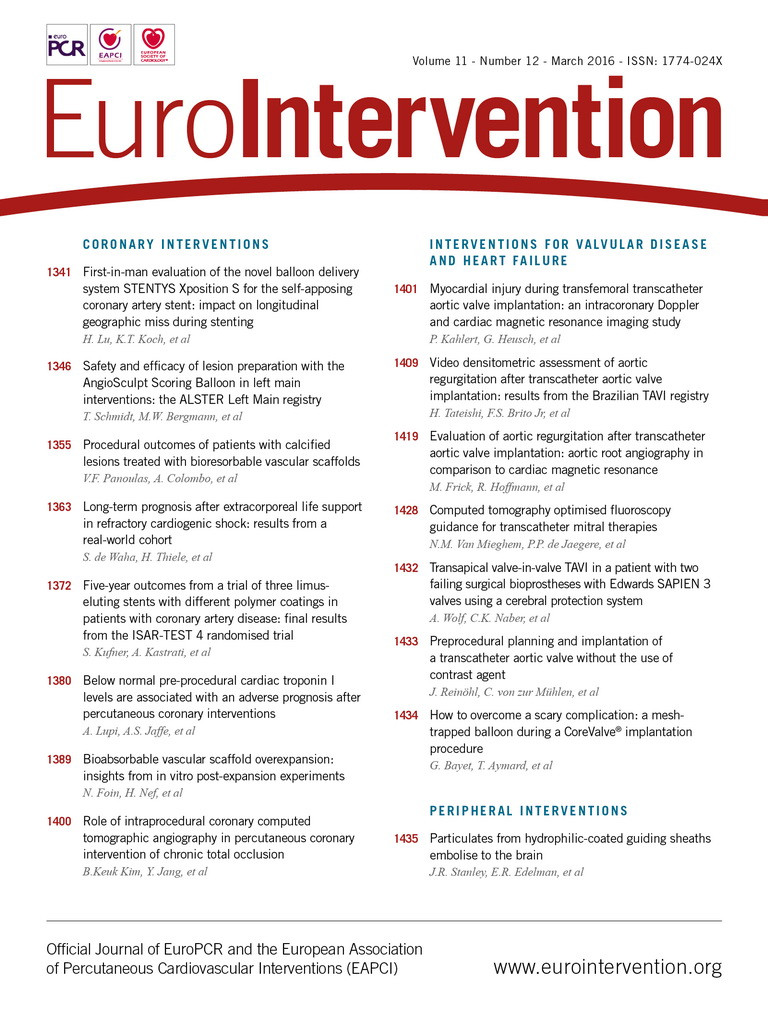
We read with great interest the manuscript of Rivero et al1 about the treatment of a recurrent in-stent restenosis (R-ISR) treated by bioresorbable vascular scaffold (BVS) implantation followed by a subacute stent thrombosis due to a subacute BVS recoil.
BVS implantation in a diabetic patient with R-ISR (due to a primitive severe calcific lesion) is an interesting treatment choice option, even if it has not been described sufficiently before in the literature and is not contemplated at the moment for this device.
BVS struts present a thickness of 157 μm, almost double that of second-generation drug-eluting stents (DES) such as the XIENCE V®, 89 μm (Abbott Vascular, Santa Clara, CA, USA)2. Even if their use has become considerably expanded, involving different settings of patients and including patients with in-stent restenosis (ISR), there are only few data regarding the revascularisation of R-ISR extrapolated from other studies.
Moscarella et al, in a multicentre BVS implantation experience of 315 patients with ISR, in which 33 patients (36%) had R-ISR after a median of seven months of follow-up, reported seven clinically driven target lesion revascularisations (TLR), six ISR and one BVS thrombosis. There were no significant differences between the groups in terms of TLR (de novo vs. recurrent: 7.0% vs. 9.1%, p=0.7)3.
In a patient with a complex and calcific lesion, described by Rivero et al, and moreover diabetic, a cardiovascular risk factor recognised as an independent predictor of ISR and TLR4, and with two previous stent implantation failures, the use of a scaffold with a strut thickness one third greater (such as the BVS) may open a debate, because of the difficulty of obtaining an adequate delivery and apposition of its struts. In their manuscript and Figures, they demonstrate an area of BVS underexpansion, realistically the possible reason for BVS recoil and subacute stent thrombosis in this complex lesion.
The risk of strut underexpansion and/or malapposition may be reasonably higher during the third stent implantation, and these considerations may lead to other treatment options such as the use of a drug-coated balloon (DCB). The use of a DCB has been proposed as a valid alternative for ISR treatment because it allows drug delivery while avoiding the further addition of a stent layer. After interesting optimal results in this population5 emerging as a safe and effective treatment option in ISR patients, the use of this device has been proposed in other complex lesions too.
Recently, Kawamoto et al6 compared for the first time the treatment of 179 patients with R-ISR by DCB vs. further second-generation DES implantation, showing how the results after both treatments were equivalent at one- and two-year follow-up (TLR at one year: DES 12.5% vs. DCB 10.9%; at two years: DES 27.7% vs. DCB 38.3%; p=0.40), opening up an intriguing alternative in the treatment of this set of complex lesions. In this specific complex lesion, such as an R-ISR in a diabetic patient, the use of a DCB may represent a valid alternative to BVS implantation.
Conflict of interest statement
The authors have no conflicts of interest to declare.

